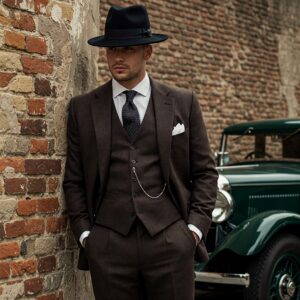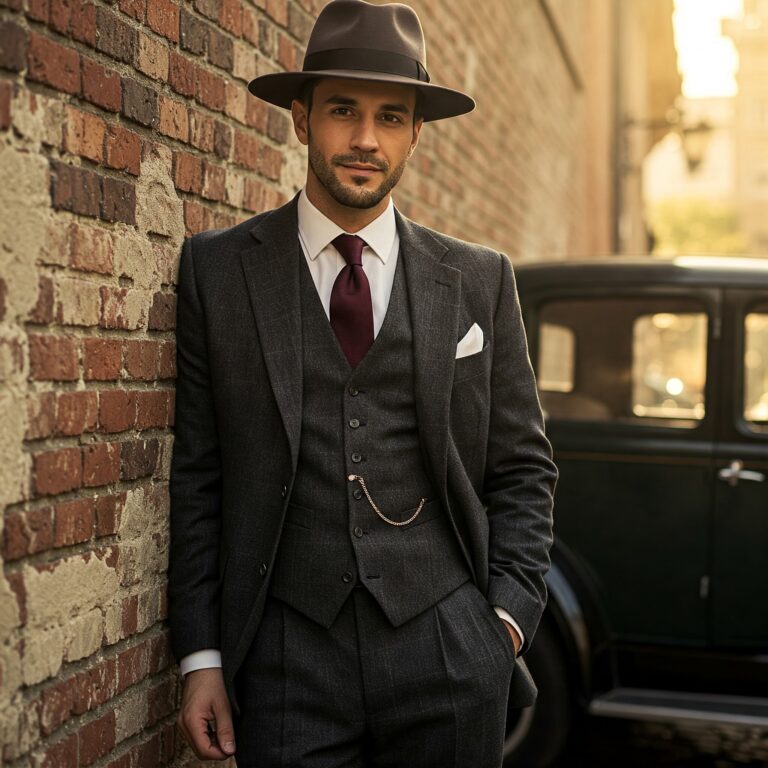The 1920s brought forth a transformative time in men’s fashion.Following the end of World War I, society experienced sweeping cultural changes, and the world of men’s suits evolved dramatically to reflect the spirit of a new, freer era. If you want to understand 1920 suit fashion, you need to look beyond the fabric and cuts — and dive into the attitude, history, and innovation that shaped them.
The Key Elements of 1920s Suits
1. Silhouette and Fit
In the 1920s, the silhouette of a suit became more relaxed compared to the rigid, form-fitting styles of the Victorian and Edwardian periods. Men favored suits with looser, straighter lines, allowing greater comfort and a sense of casual elegance. Trousers grew wider (sometimes referred to as “Oxford bags”), and jackets hung a little lower on the body.
However, tailoring still mattered. Even in their relaxed forms, suits were structured carefully to maintain a polished, respectable look. A well-fitted jacket emphasized the shoulders and chest but offered more breathing room at the waist.
2. Fabrics and Colors
The Roaring Twenties embraced a wider variety of fabrics. Men wore wool, tweed, flannel, and linen suits depending on the season and occasion. Color palettes expanded beyond sober blacks and navies; earthy browns, soft grays, rich blues, and even pastel shades came into fashion.
Patterns such as herringbone, plaid, and pinstripes also gained popularity, adding texture and flair to the traditional male wardrobe.
3. Three-Piece Suits
An iconic element of 1920s men’s fashion was the three-piece suit, featuring coordinated trousers, a vest (often called a waistcoat), and a tailored jacket. Waistcoats often featured interesting details like lapels and sometimes contrasted slightly in color or fabric with the rest of the suit, especially in more casual settings.
Double-breasted jackets also started gaining traction toward the end of the decade, offering men more options for stylish sophistication.
4. Accessories: The Final Touch

No 1920s suit was complete without the right accessories:
-
Neckties: Often featuring bold Art Deco patterns.
-
Pocket squares: Adding a splash of personality.
-
Suspenders: Commonly worn under jackets since belts were still a new concept.
-
Hats: Such as the fedora, homburg, and boater — nearly every man wore a hat daily.
-
Two-tone shoes: Often worn for more casual or social events.
Accessories allowed men to personalize their looks even within the bounds of formality.
The Cultural Impact
1920 suit fashion wasn’t just about looking good — it symbolized a break from the old-world formality and an embrace of modernity. The post-war generation wanted to celebrate life, and their clothes reflected optimism, energy, and a willingness to push boundaries.
This was the era of The Great Gatsby, jazz clubs, and speakeasies. Men’s fashion aligned with the vibrant, rebellious spirit of the time. Suits were not just for work — they were for dancing, socializing, and enjoying life to its fullest.
Conclusion
Understanding 1920 suit fashion is about appreciating the perfect blend of tradition and innovation. It was a decade where men began to express themselves more freely through their clothing while still valuing craftsmanship and style.
Today, echoes of 1920s suit fashion remain popular — a testament to the era’s lasting influence on menswear.


